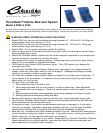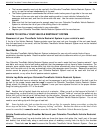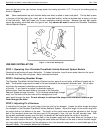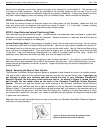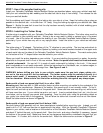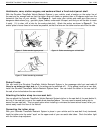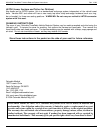
2000/2500 TheraPedic™ Vehicle Restraint System Instructions Rev: 10.06
2-7
• The harness assembly must only be used with the Columbia TheraPedic Vehicle Restraint System. Do
not try to use the harness independently of the seat.
• The Federal government recommends that children under twelve years of age ride in the rear seat.
The center of the rear auto seat is the safest seating position in most vehicles, followed by the
passenger-side rear seat, and then the driver-side rear seat. Use the center rear seat whenever
possible.
• Make sure that the front seats are far enough away from your Columbia TheraPedic Vehicle Restraint
System to minimize the risk of your child striking them in an accident.
• Never leave the occupant unattended in your automobile.
• Register your Columbia TheraPedic Vehicle Restraint System with the manufacturer.
WHERE TO INSTALL YOUR VEHICLE RESTRAINT SYSTEM
Placement of your TheraPedic Vehicle Restraint System in your vehicle's seat:
If the lip of the Vehicle Restraint System projects more than one inch over the edge of the car’s seat bench,
then the seat bench is too small, and the Columbia TheraPedic Vehicle Restraint System must not be installed
in that seating position.
Seat Belts
Your Columbia TheraPedic Vehicle Restraint System is designed for use only with certain kinds of lap or
combination shoulder/lap belts. Read the section below on seat belts to determine which of your vehicle's seat
belts are suitable.
Your Columbia TheraPedic Vehicle Restraint System cannot be used in seats that have "passive restraint" -type
seat belts, such as any kind of self-locking seat belt that the passengers do not have to fasten themselves. For
example, some vehicles have shoulder belts that slide into place automatically when the passenger closes the
door, and then slide out of the way automatically when the passenger opens the door. Because the seat belt
tension cannot be properly controlled, your Columbia Restraint System must not be used with this kind of
passive restraint, or any other kind of passive restraint systems.
Vehicle Lap Belts and your Columbia TheraPedic Vehicle Restraint System:
Yes! Lap belts that have no retractor, but rely on the passenger to pull on the free end of the belt to set the
lap belt to the proper tension can be used to secure the Columbia TheraPedic Vehicle Restraint System.
Simply attach the locking clip as shown in Figure 1 once you have adjusted the belt to the proper tension.
Snug the locking clip within 1/2" of the buckle.
Yes! Another kind of lap belt feeds into and out of a retractor. When you pull on the free end of the belt, if
you stop pulling, or allow the belt to go back into the retractor, the belt "locks up" and can't be pulled out any
further until you let the belt go all the way back into the retractor. Because you can control the tension of this
kind of seat belt, it can be used to secure the Columbia TheraPedic Vehicle Restraint System. You do not
need to use a locking clip with this type of seat belt.
No! Some lap belts only lock up when the nose of the car dips, for example, during an accident, or when the
driver steps on the brake. These are "emergency-locking" seat belts. Because the tension on this kind of belt
cannot be controlled, it cannot be used to secure the Columbia TheraPedic Vehicle Restraint System.
Vehicle Combination Lap/Shoulder Belts and your Columbia TheraPedic Vehicle Restraint
System:
Yes! “Continuous-Loop” lap and shoulder belts are those that have a lock plate (the “male” part of the seat
belt buckle) that slides freely along a continuous piece of webbing running from the hip to the shoulder
retractor. These belts can be used to secure the Columbia TheraPedic Vehicle Restraint System. Once you



